


The third day of the eleventh edition of the 4K HDR Summit, the first in virtual format, held in Seville from 11 to 14 November, brought together leading experts and representatives from the global audiovisual industry, who presented the latest advances in Ultra High Definition technologies, artificial intelligence, sustainability, immersive audio and new production and broadcasting experiences. Throughout the presentations, the role of innovation as the driving force behind the future of the audiovisual sector and digital terrestrial television was reaffirmed.
While 4K is still being progressively implemented in Europe and most of the world, Japan is already conducting tests with a resolution that is seven times higher than this technology. Tetsuya Hayashida, Principal Research Engineer at NHK, presented an innovative 30K and 360° video system capable of offering an unprecedented immersive experience. The project combines an omnidirectional camera based on a pentagonal prism with hemispherical and curved screens made up of 16 OLED panels. “Our goal is to achieve real-time 360° video in Ultra High Definition,” he explained, noting that artificial intelligence is essential for image assembly and enhancement. This technology, exhibited at IBC 2025, points towards “the next generation of immersive broadcasting“.
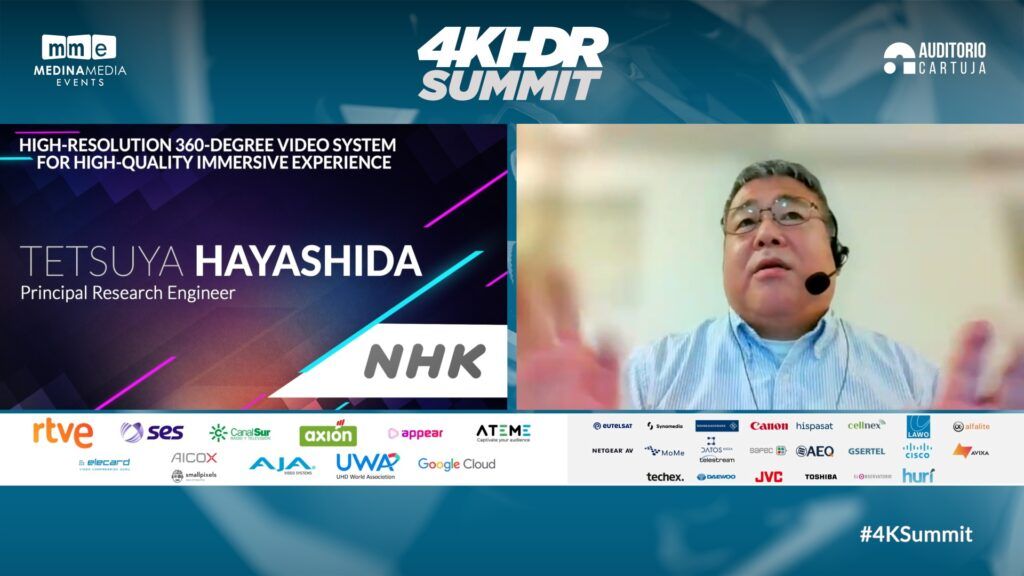
For its part, Canon presented its new EOS C50 cinema camera, “the smallest and lightest to date,” according to Aron Randhawa, Senior Product Marketing Specialist at Canon. This model incorporates a 7K sensor with Open Gate RAW recording, 32 MP stills, over 15 stops of dynamic range and dual ISO, offering “exceptional image quality” for both professional productions and digital content creators. In addition, its simultaneous recording in landscape and portrait formats makes it a hybrid tool for both cinema and social media. Randhawa emphasised that with the C50, they seek to “combine cinematic power and digital versatility” to respond to new market demands.
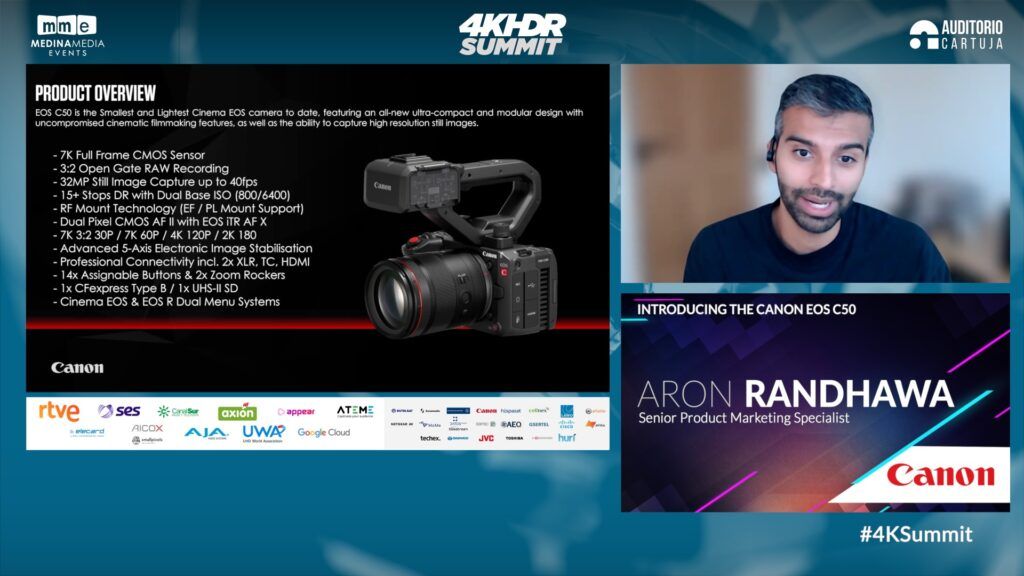
From Brazil, Carlos Cosme, Technology Innovation Specialist at Globo, presented the progress of the TV+ (TV Place) project, the country’s new digital terrestrial television standard, which merges traditional broadcasting with the digital ecosystem. “We want to offer more interactive, personalised and higher quality television,” he said. The system integrates 4K HDR, immersive audio and hybrid connectivity (over the air and over the top). Cosme announced that the commercial launch is scheduled for June 2026, coinciding with the FIFA World Cup, and highlighted that the new standard “is already compatible with 8K,” although its implementation will be gradual.
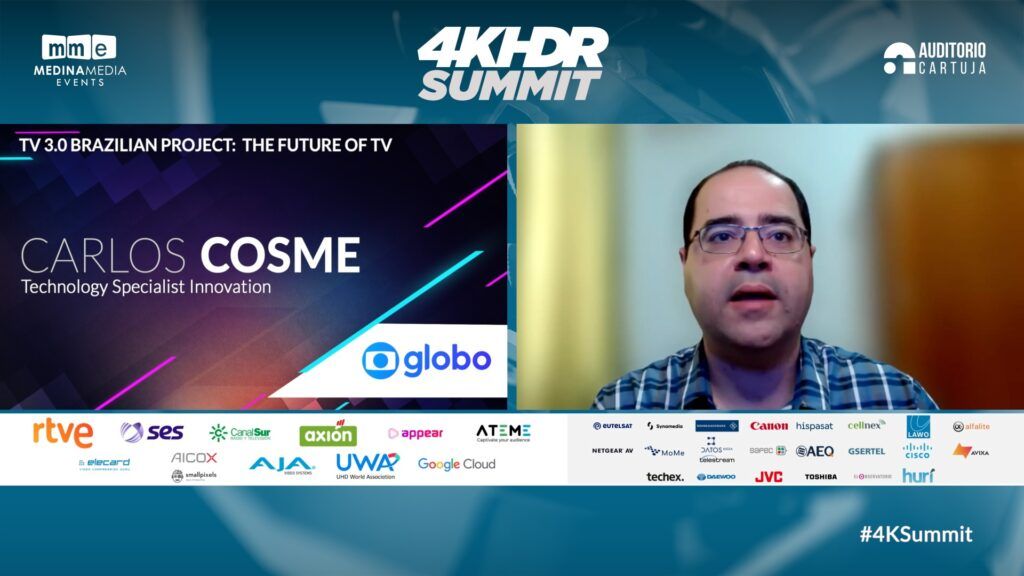
Jan de Cock, Director of Development, Video Network at Synamedia, presented the company’s developments in measuring and optimising UHD video quality, with tools that apply artificial intelligence and machine learning. He introduced PVMAF, a predictive version of the VMAF algorithm that is “up to 100 times faster” and designed for live video. He also presented the Live Video Quality Agent system, which allows real-time signal comparison and monitoring. “These tools enable cost optimisation, workflow improvement and data-driven decision making,” he said, noting that artificial intelligence “is already integrated into all our processes.”
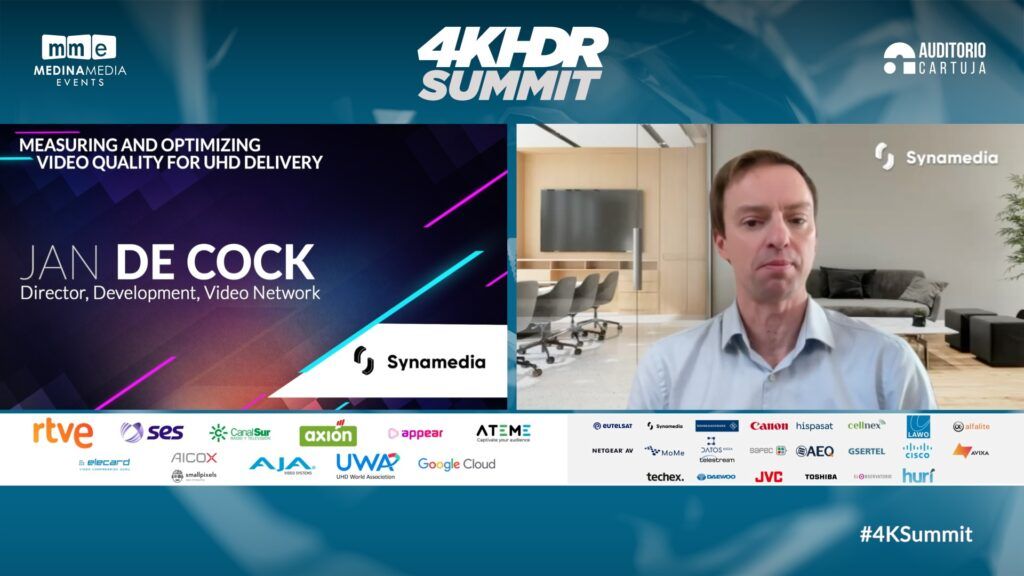
Nuno Duarte, Sound Designer and Audio Manager at Olympic Broadcasting Services (OBS), discussed advances in 5.1.4 immersive audio, which will be consolidated at the 2024 Olympic Games in Paris. Looking ahead to Milan 2026, he announced that OBS is moving towards “a completely IP-based production” and will incorporate artificial intelligence to “improve management, quality control and efficiency in sound mixing.” Duarte pointed out that “AI does not replace staff, but frees up time to focus on the details,” highlighting that the industry is moving towards “a more virtual, flexible and sustainable future.”

Jorge Rodríguez, Head of Product and Marketing at Hispasat, opened the day by highlighting the role of satellite as “an efficient and sustainable means of distributing Ultra High Definition content“. He presented a study that ranks satellite as “the second most energy-efficient and energy- tion option, behind only DTT“. He also pointed out that the company already has more than 1.4 million users in Latin America and noted that “although the adoption of 4K televisions is growing rapidly, the number of UHD channels remains low.” He therefore proposed promoting the transition from DTT to UHD and improving communication with users to “encourage their understanding and adoption.”

Xavi Redón, Product Manager at Cellnex, gave a historical overview of the evolution of Digital Terrestrial Television (DTT) in Spain until the arrival of Ultra High Definition, whose “full adoption” he estimates will take place “between 2027 and 2030“. He highlighted that Spain is a world leader in UHD broadcasts via DTT and advocated that “regulations requiring 4K-compatible televisions larger than 40 inches will facilitate this transition.” Drawing on data from a survey conducted by UHD Spain, he pointed out that “66% of Spanish households have the right conditions for 4K, although less than half are prepared.” Regarding Cellnex, he indicated that Spain’s largest infrastructure company uses artificial intelligence to optimise network management, automate processes and plan future infrastructure.
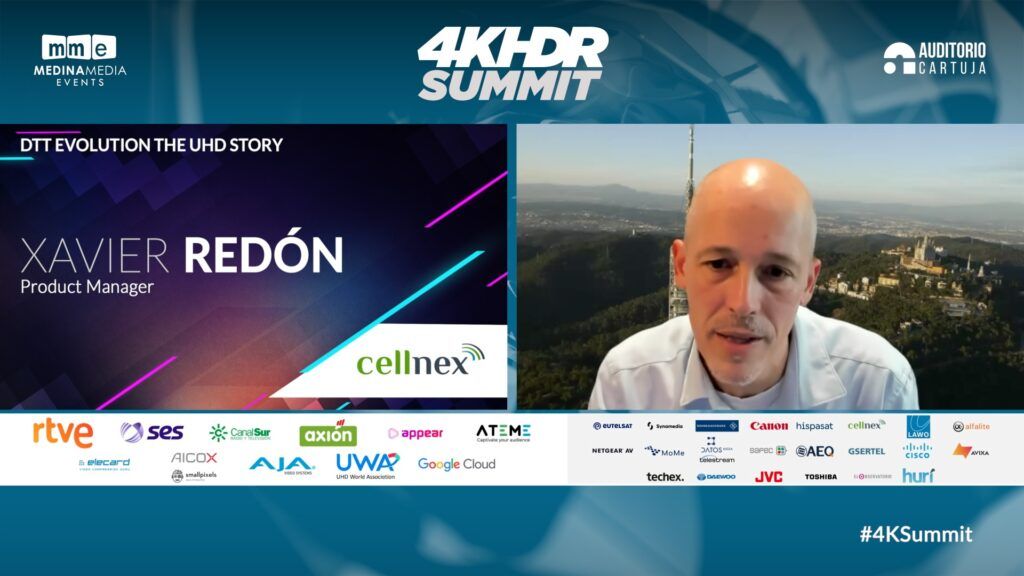
In the field of technical broadcasting, Manuel Ángel Álvarez, Technical Sales Area Manager for LATAM and Europe at Gsertel, presented the company’s solutions for measuring and monitoring UHD signals, highlighting drive tests with its Hexilon portable analyser. “These tests allow real signal parameters to be measured and areas without coverage to be identified,” explained the technician, who stressed the importance of offering reliable and continuous services and reaffirmed the company’s commitment to “practical innovation, diversification towards mobile networks and IoT, and energy efficiency as a commitment to the future.”
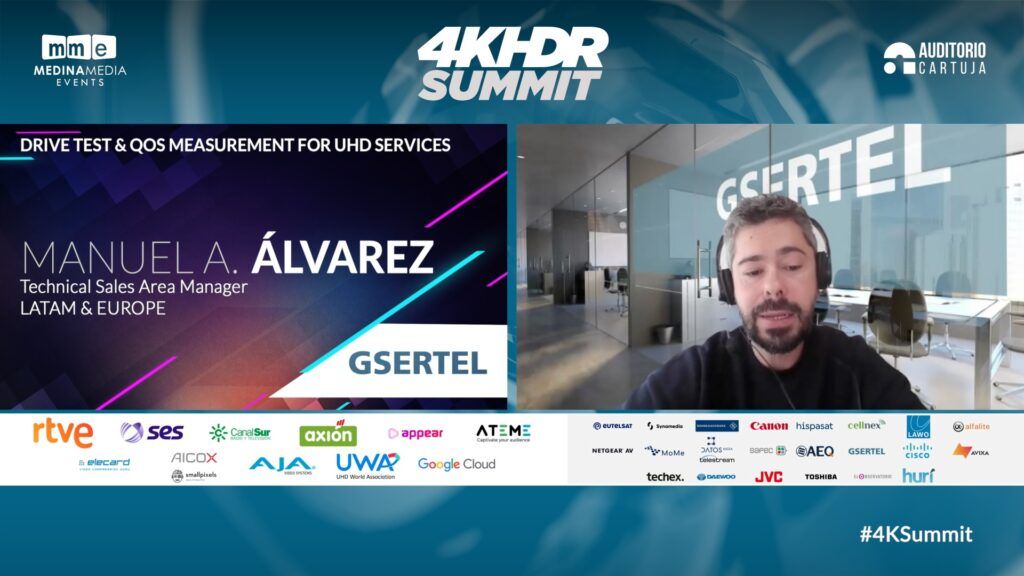
For his part, Ian Nock, Chair of the Ultra HD Forum’s Interoperability Working Group and Managing Consultant at Fairmile West Consulting, recalled that the organisation has been working for a decade on interoperability and best practices in Ultra HD. In his speech, he pointed out that “the real value of Ultra HD lies not only in resolution, but also in HDR, wide colour gamut and next-generation audio“. Nock acknowledged that the transition to these technologies is “a gradual evolution,” with challenges in the integration of HDR and SDR content, and highlighted the need to “educate consumers about the importance of the right screens.”

Expert Benjamin Schwarz, COO of Greening of Streaming, focused his speech on the sustainability of streaming, highlighting the urgency of measuring the audiovisual sector’s energy consumption “accurately and with real data“. From his organisation in Paris, he leads projects such as REM (Remote Energy Measurement), which analyses the energy consumption of devices and networks in real time. Schwarz warned that “many domestic devices continue to consume energy even when not in use” and that reducing content resolution “can increase total consumption due to the automatic rescaling of 4K televisions.” He also stressed that “sustainability will only advance if it is integrated into business strategy and supported by common protocols.”
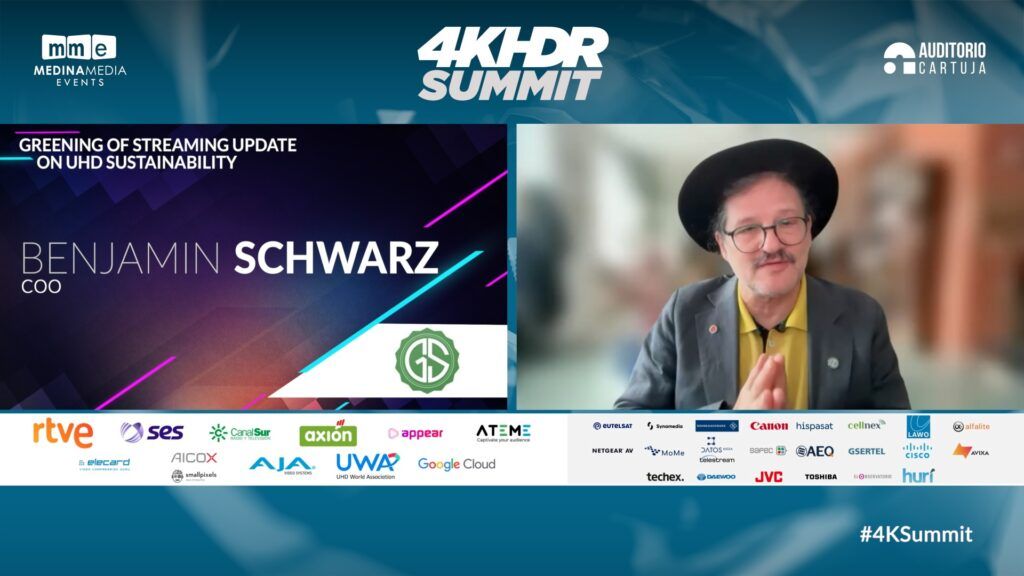
For his part, Frans de Jong, Media Fundamentals & Production Technology at the European Broadcasting Union (EBU), presented the organisation’s latest tests in HDR and UHD, focusing on colour enhancement, visual consistency and compression. He explained that the new EBU recommendations seek to “standardise HDR monitor modes” and address the phenomenon of metamerism, which alters colour perception. The tests determined that “the optimal compression for UHD transmissions is between 6:1 and 8:1″ and that motion compensation “offers the best results in frame conversion.” De Jong emphasised the importance of “maintaining dialogue between technology and production” and the role of the cloud and artificial intelligence as the basis for the audiovisual flows of the future.

This Friday, 14th November, marks the final day of the 4K HDR Summit 2025. The ‘Women in Tech & Contents’ space will bring together a group of renowned international professionals from the audiovisual and technology sector, who will share their experiences and reflections in a series of inspiring interviews. This day will also feature the participation of prominent presidents of television stations and major global UHD associations, such as Rafael Porras, President of RTVA; Bill Baggelaar, President of the UHD Alliance; Sam Matheny, President of the Ultra HD Forum; Juan Reyes, Executive Director of the 8K Association; and Ines Gdoura, Head of Operation and Production at the Arab States Broadcasting Union, among others.
The 4K HDR Summit 2025 is organised by Medina Media Events and supported by RTVE, SES, RTVA, Axión, Appear, Ateme, Google Cloud, Elecard, Aicox con Small Pixels, AJA, UWA, Lawo, Eutelsat, Synamedia, Rohde & Schwarz, Canon, Hispasat, Cellnex, Alfalite, Netgear, MoMe, Datos Media con Telestream, Sapec, AEQ, Gsertel, Techex, Cisco, Avixa, Hurí, Sevilla FC, Vestel, Daewoo, JVC and Toshiba, among others.
All conferences will be available for viewing on demand through ‘The Observatory’, Medina Media Events’ digital platform, where each conference can be viewed throughout the year, 24 hours a day, free of charge.